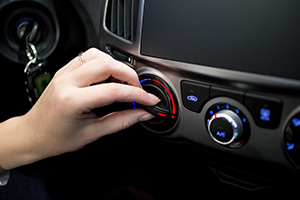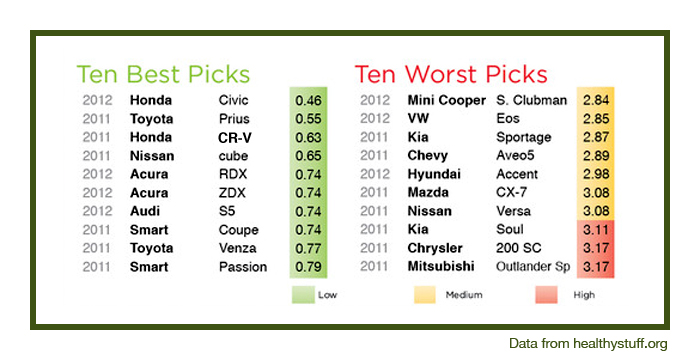
I recently learned that the temperature inside a car on a hot July day can be 40 degrees hotter than the temperature outside. So, if it’s 90 degrees outside when I jump in the car, inside it’s a raging 130 degrees! Of course it’s hot and most everyone’s first move is to turn on the A/C to cool down. Not so fast, everyone! We’ve all heard how it’s not healthy to leave a water bottle out in the sun. The plastic, when heated, releases toxins into the water. Well, the same thing is happening when we jump into our steaming, hot cars.

Grocery shopping, work and other errands contribute to almost the 1.5 hours per day the average American spends in their cars.
The average American spends over 1.5 hours in their car everyday. Car seat cushions, arm rests, shift knobs, center consoles, dashboards, door panels, steering wheels, seat bases, seat fronts and backs, body seals, window seals, and most of the other plastic “knobs” found in cars are part of the 250 pounds of plastic used in new cars according to an article by CNN in 2008.
Whew! That’s a lot of plastic but there’s no need to panic! We’re all in the same “boat” so to speak. Just being aware gives us huge opportunities to make easy, daily, healthy choices, even when it comes to getting in and out of ours or others cars during the hot summer months.
8 Easy, Everyday ways to protect ourselves, children, pets and other passengers:
-

How about airing your car out for 5 to 10 minutes before climbing in?
If you’re going to be working or parked for a long period of time, try to park in shade
- Buy a sun reflector for your windshield
- Open your windows and don’t turn on the air conditioner for a good 5 minutes to air out your car and eliminate off-gassing chemicals
- When you turn on your A/C, then be sure to use the “fresh air” and not the “recirculated air” setting
- When you park your car, leave the windows cracked open a bit to increase ventilation
- Open doors and windows and let the car air out if you have some spare time
- Ride your bike when you can or use public transportation
- Give Uber or your favorite taxi service your business

Many of these interior car parts are made from toxic chemicals like phthalates and PVC.
New cars tend to off-gas higher loads of toxins since they’re most recently off the assembly line. Off-gassing is the process by which chemicals from plastics, foams, and other synthetic materials released. The Ecology Center’s best advice is to make sure the car interior is well ventilated during the first six months of ownership, including bringing in fresh air and ensure it circulates and/or driving with the windows down. Nice to know that the chemical levels reduce the longer one owns a car.
If you’ve purchased a new car recently, especially during the summer months, just remember to be especially mindful of increasing ventilation. Opening the windows for a mere 5 minutes after you get into your car does a lot to clear and clean the air. If you’re lucky to be driving a convertible, well, better yet!
Other good news! Automobile makers have been making an effort to improve the air quality of car interiors by using alternative products to the ones listed above. Toxic chemicals are not required to make interior auto parts and some manufacturers are beginning to phase them out, according to Ariel Schwartz, Senior Editor at Co.Exist. Since 2006, 103 cars have tested PVC-free!
HealthyStuff.org has published their Best and Worst Picks, a new guide to help Consumers Avoid “New Car Smell” as Major Source of Indoor Air Pollution.
Best Picks: Honda Civic, Toyota Prius, Honda CR-V
Note: As you read the table below, the rankings reveal the most and least toxic new cars on the market based on levels of chemicals, with 1 being the least and 5 being the most toxic. Believe it or not, this table was created and published in 2012. I have reached out several times to get a current study to no avail. I also just reached to healthy stuff.org to see if they’re working on an updated list. In the meantime, if you’re shopping around, ask the dealer about the new/current standards for the vehicle you are looking at.

For those of you interested in learning more about some of the specific chemicals that contribute to poor car air quality, especially when mixed with the high temperatures on a windshield from a summer sun, I encourage you to read on.

Our children and pets are also at risk for serious health issues without proper car ventilation.
In addition to formaldehyde, naphthalene and carbon disulfide used in the adhesives, foams and fabrics, two other major chemicals are also widely used in car interiors:
- PBDEs – used as fire retardant
- Phthalates – widely used to soften PVC (Polyvinyl chloride) plastic. (Read more about PVC in my post www.thenontoxiclifestyle.com/reduce-voc/
Vinyl, also known as PVC, causes “fogging” on the inside of windshields and is one of the worst types of plastics, linked to fertility problems and cancer. While your car might have leather seats, the sides and back of the seats are made of vinyl. According to Jeff Gearhart, The Ecology Center’s Auto Project Campaign Director, “Consumers can’t tell, because the vinyl manufacturers have done a great job of making it look exactly like leather.”
In 2000, the CDC discover high levels of phthalates in all of the 289 adult Americans they tested. And that was 15 years ago.
The combination of high temperatures coming through our windows and windshield can cause PBDE flame retardants to become even more toxic, up to five times higher than in our homes. (The Ecology Center)
An article initiated by The Ecology Center, a 2006 report called “Toxic at Any Speed: Chemicals in Cars and the Need for Safe Alternatives,” has been quite eye opening. This report deemed that we, as drivers, are breathing toxic air, with dangerous chemicals leaching from almost every interior surface of new cars. Extended research by EC also revealed higher levels of chemicals in our cars than in our homes and offices, “making in-car pollution a major health danger.” Chronic exposure tends to build up in people and may lead to health issues. Heat and UV exposure accelerates the release of many chemicals in water bottles and now, as we learn, in our cars.

Biking to work during good weather is a healthy alternative to commuting by car.
What are the health dangers of breathing these chemicals?
- Breast Cancer and uterine fibroids
- Early or delayed puberty
- Numerous hormonal disruptions
- Linked to birth defects and premature births
- Liver toxicity
- Nervous and immune system issues
- Memory loss
I’m not one to judge how much time people spend in their cars. We drive cars for work and for many other reasons. During the summer we use cars for our treks to the beach and mountains and family visits and vacations in other locations. I write this blog to bring about awareness and to hopefully help others, including myself, find everyday, easy ways to reduce toxic exposure in our lives. I didn’t know myself about car interior off-gassing until about 5 years ago. When I discover something new like this, it’s an “ah-ha!” moment for me because I feel I’ve gained new knowledge. I’m also newly empowered to make positive, healthy, easy changes for myself and those I love. And it’s fun and important to share with friends.

Leaving car doors and windows open while you are nearby makes for healthier and cooler air to breathe.
Yep, the first few minutes in a hot car are a bit uncomfortable. But by rolling down the windows and leaving the AC off for at least five minutes, I know I’m choosing what I want to breathe when I get in my car. And that’s peace of mind and individual empowerment.
Join me this summer in “Choosing Clean Air” in your cars!
Breathe with Peace of Mind!
![]()
Sources:
American Cancer Society
CNN-Don’t inhale that new car smell (July 2008)
Dr. Mercola
FastCoExist-Ariel Schwartz (Feb 2012)
GreenGuard.org
HealthyStuff.org
Jeff Gearhart, Ecology Center Auto Project Campaign Director
The Ecology Center
If you “Like” this post, I’d be thrilled if you’d share it.
JUL
